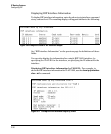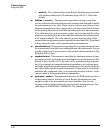
IP Routing Features
Configuring DHCP Relay
The DHCP relay agent is transparent to both the client and the server. Neither
side is aware of the communications that pass through the DHCP relay agent.
As DHCP clients broadcast requests, the DHCP relay agent receives the
packets and forwards them to the DHCP server. During this process, the DHCP
relay agent increases the hop count by one before forwarding the DHCP
message to the server. A DHCP server includes the hop count from the DHCP
request that it receives in the response that it returns to the client.
DHCP Packet Forwarding
The DHCP relay agent on the routing switch forwards DHCP client packets to
all DHCP servers that are configured in the table administrated for each VLAN.
Unicast Forwarding
The packets are forwarded using unicast forwarding if the IP address of the
DHCP server is a specific host address. The DHCP relay agent sets the
destination IP address of the packet to the IP address of the DHCP server and
forwards the message.
Broadcast Forwarding
The packets are forwarded using broadcast forwarding if the IP address of the
DHCP server is a subnet address or IP broadcast address (255.255.255.255).
The DHCP relay agent sets the DHCP server IP address to broadcast IP address
and will be forwarded to all VLANs with configured IP interfaces (except the
source VLAN).
Prerequisites for DHCP Relay Operation
For the DHCP Relay agent to work on the switch, you must complete the
following steps:
1. Enable DHCP Relay on the routing switch (the default setting).
2. Ensure that a DHCP server is servicing the routing switch.
3. Enable IP Routing on the routing switch.
4. Ensure that there is a route from the DHCP server to the routing switch
and back.
5. Configure one or more IP helper addresses for specified VLANs to forward
DHCP requests to DHCP servers on other subnets.
3-44


















